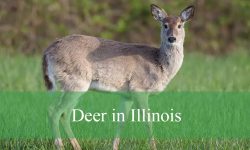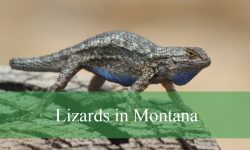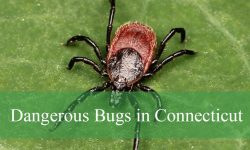If you have ever noticed a strong musky scent drifting through the Nebraska countryside, you have probably been near one of the state’s native skunks. Nebraska is home to two distinct skunk species, the Striped Skunk (Mephitis mephitis) and the Eastern Spotted Skunk (Spilogale putorius). These small mammals are famous for their bold black-and-white coats and powerful defensive spray, but they also play an important role in the ecosystem by controlling insect and rodent populations.
While both species share certain similarities, each has its own unique appearance, habits, and habitat preferences. Skunks are often misunderstood animals, yet they are vital to maintaining balance in Nebraska’s natural and agricultural landscapes. Understanding how to identify and respect them helps reduce conflicts and increases appreciation for local wildlife.
In this identification guide, you will learn about the two types of skunks found in Nebraska, including their physical characteristics, behavior, distribution, and ecological roles.
Understanding Skunks in Nebraska
Skunks belong to the family Mephitidae, which includes several species native to North and Central America. They are medium-sized mammals known for their strong scent glands, capable of producing a sulfur-based spray that repels predators. Although their odor gives them a notorious reputation, skunks are actually shy and only use their spray as a last resort.
In Nebraska, skunks are primarily nocturnal, meaning they are most active at night. They are opportunistic feeders, consuming insects, small mammals, fruits, and even carrion. They are adaptable and thrive in many environments, from open grasslands to suburban neighborhoods.
Two skunk species live in Nebraska: the Striped Skunk, which is common throughout the state, and the Eastern Spotted Skunk, which is smaller, more agile, and found mainly in southeastern and central regions.
Striped Skunk (Mephitis mephitis)
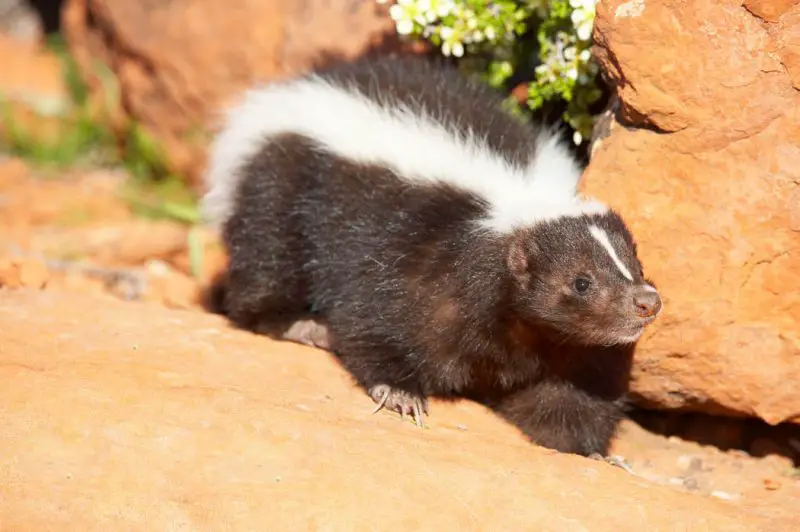
Identification and Appearance
The Striped Skunk is the most familiar skunk species in Nebraska. Its striking black coat with two bold white stripes running from the head to the tail makes it easy to recognize even in dim light. Some individuals have narrow stripes that merge into a single line down the back, while others display broader bands.
Adults typically measure 20 to 30 inches long, including the tail, and weigh between 4 to 10 pounds. The striped skunk has a stocky body, short legs, and strong claws designed for digging. Its fur is thick and glossy, providing insulation during Nebraska’s cold winters. The large, bushy tail is often carried upright when the animal feels threatened.
Although the skunk’s appearance is distinctive, its bold coloration also serves as a warning to predators to keep their distance.
Behavior and Temperament
Striped skunks are solitary and nocturnal, spending their nights searching for food. They are omnivorous, feeding on insects such as beetles, grubs, and grasshoppers, along with small rodents, bird eggs, fruits, and even garbage in suburban areas.
When frightened, a striped skunk performs a series of warning behaviors. It may stamp its feet, hiss, and raise its tail before releasing its spray. The oily musk contains sulfur compounds that cause temporary blindness and a lingering odor. Skunks only spray when necessary since producing the scent requires energy and takes time to replenish.
During the coldest months, striped skunks enter a state of torpor, reducing their activity but not fully hibernating. Females may share dens with other females for warmth, while males usually remain alone.
Habitat and Distribution in Nebraska
The striped skunk is found throughout Nebraska, from the eastern river valleys to the western plains. It thrives in open areas such as grasslands, farmlands, and pastures. Skunks also inhabit wooded edges, brushy fields, and urban environments.
They make dens in burrows, hollow logs, under rock piles, or beneath buildings. In rural settings, they are frequently seen near barns, sheds, and haystacks. Their adaptability to various environments allows them to coexist with humans, although this can sometimes lead to conflicts when they seek shelter under decks or porches.
In agricultural regions, striped skunks are considered beneficial because they consume pests that damage crops and livestock feed.
Breeding and Lifecycle
The breeding season for striped skunks begins in late February or early March. Males travel long distances to locate receptive females. After a gestation period of 60 to 75 days, females give birth to 4 to 6 kits in May or June.
Kits are born blind and hairless, relying entirely on their mother for warmth and nourishment. They begin venturing out of the den at around eight weeks old. By autumn, the young skunks disperse to establish their own territories.
Most striped skunks live two to three years in the wild, although many do not survive their first year due to predators, vehicles, or harsh weather.
Role in the Ecosystem
Striped skunks play a key ecological role in Nebraska’s environment. They help control populations of insects, rodents, and other pests that can harm crops and spread disease. They also scavenge carrion, aiding in the natural recycling of organic material.
Predators of striped skunks include great horned owls, bobcats, and coyotes. Interestingly, great horned owls are not affected by skunk spray, making them one of the skunk’s few natural threats.
Interesting Facts
- Striped skunks can spray accurately up to 10 feet.
- Their odor can be detected by humans from nearly half a mile away.
- They are immune to rattlesnake venom.
- Their white stripes serve as a visual warning to potential predators.
Eastern Spotted Skunk (Spilogale putorius)
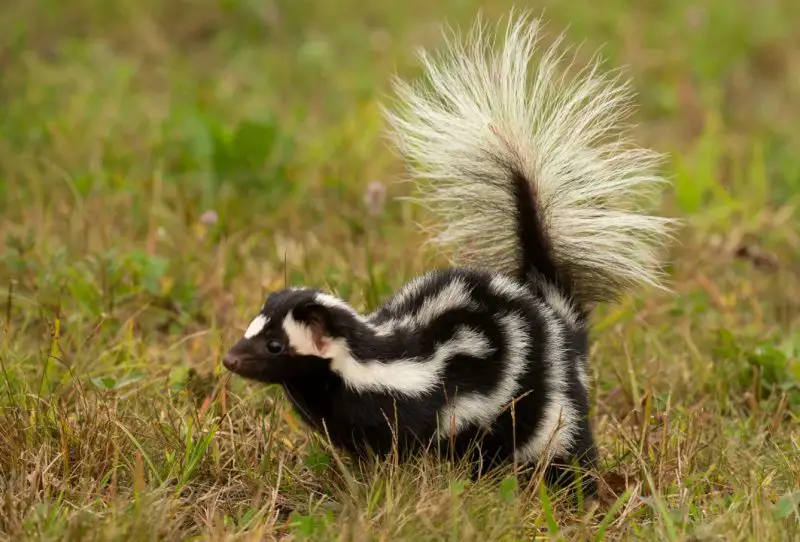
Identification and Appearance
The Eastern Spotted Skunk is smaller and rarer than the striped skunk. Its fur pattern consists of broken white spots and short stripes scattered across a black coat. This irregular pattern provides excellent camouflage in dense vegetation.
Adults measure 16 to 24 inches long, including the tail, and weigh between 1 to 3 pounds. The body is slender, with a narrow head, short legs, and large ears. The tail is bushy and tipped with white. Despite its small size, this skunk is known for its remarkable agility and acrobatic defensive display.
When threatened, the Eastern spotted skunk performs a handstand, balancing on its forelegs with its tail raised before releasing its spray. This unique behavior distinguishes it from all other skunk species.
Behavior and Temperament
Eastern spotted skunks are secretive and agile, spending most of their time in brushy or wooded habitats. They are primarily nocturnal and feed on insects, small mammals, birds, eggs, and fruits. They are more carnivorous than striped skunks, often hunting small prey rather than scavenging.
These skunks are excellent climbers, capable of scaling trees, fences, and logs in search of food or safety. When threatened, they may hiss, stomp, and perform their handstand display before spraying. This behavior serves as both a warning and a balancing act to aim their spray accurately.
Although they are capable of defending themselves, spotted skunks are more likely to flee than fight, relying on their agility and camouflage.
Habitat and Distribution in Nebraska
The Eastern Spotted Skunk is found mainly in southeastern and central Nebraska, where wooded hillsides, grassy fields, and farmlands provide suitable cover. Historically, it was more widespread, but habitat loss and pesticide use have reduced its range.
These skunks prefer dense vegetation, brush piles, and rocky outcrops for denning. They may also use hollow trees or abandoned burrows. Unlike striped skunks, they avoid highly urbanized areas and require quiet, natural habitats to thrive.
During winter, spotted skunks remain in their dens for extended periods but do not hibernate completely. They rely on stored fat and limited activity to survive cold conditions.
Breeding and Lifecycle
Eastern spotted skunks have a unique reproductive strategy involving delayed implantation. Breeding occurs in late winter, but the fertilized egg remains dormant for several months before developing. This adaptation allows kits to be born in favorable spring conditions.
After an effective gestation period of about 50 to 65 days, females give birth to 4 to 6 kits in April or May. The young remain in the den for several weeks before venturing outside. By late summer, they are independent and capable of spraying.
Spotted skunks live around three to four years in the wild. Their populations fluctuate depending on habitat quality, predator density, and food availability.
Role in the Ecosystem
Spotted skunks are valuable components of Nebraska’s ecosystem. They help control populations of insects and small rodents, which benefits agriculture and natural habitats. They also consume berries and fruits, contributing to seed dispersal.
Because their numbers have declined, Eastern spotted skunks are listed as a species of conservation concern in several Midwestern states. Protecting grasslands, woodlands, and natural corridors is essential to maintaining their population.
Interesting Facts
- Eastern spotted skunks are skilled climbers and can easily scale trees.
- They are sometimes called “civet cats” because of their scent and spotted fur.
- Their handstand spray defense is one of the most unique behaviors among North American mammals.
- Their population decline highlights the importance of habitat conservation in Nebraska.
Differences Between the Two Skunks
Feature |
Striped Skunk (Mephitis mephitis) |
Eastern Spotted Skunk (Spilogale putorius) |
|---|---|---|
Size |
20–30 inches long, 4–10 lbs |
16–24 inches long, 1–3 lbs |
Color Pattern |
Broad white stripes on black fur |
Irregular white spots and short stripes |
Habitat |
Open fields, farms, and suburbs |
Wooded areas, grasslands, rocky terrain |
Behavior |
Ground-dwelling, slow-moving |
Agile climber, performs handstands |
Distribution |
Found statewide |
Mainly southeastern and central Nebraska |
Population |
Common and stable |
Declining, conservation concern |
Coexistence with Humans in Nebraska
Both skunk species sometimes wander into human-inhabited areas, especially during warm months when food is plentiful. While their presence can cause concern, skunks are actually helpful because they eat insects and rodents that damage crops and gardens.
Conflicts usually occur when skunks seek shelter under houses or decks. To reduce problems, homeowners should seal openings beneath buildings, remove outdoor food sources, and keep garbage containers tightly closed. Motion-activated lights or sprinklers can also help deter nighttime visits.
If a skunk sprays near your property, a mixture of hydrogen peroxide, baking soda, and dish soap can help neutralize the odor. Always remember that skunks spray only when they feel cornered, so allowing them space to retreat is the best solution.
Conservation and Observation
The Striped Skunk remains common throughout Nebraska, but the Eastern Spotted Skunk is in decline. Conservation programs emphasize habitat protection, reduced pesticide use, and monitoring population trends.
Nature enthusiasts can spot skunks during evening or early morning hours near wooded edges or farmlands. Observing from a safe distance with a red light helps prevent startling them. If you encounter a spotted skunk, consider reporting it to local wildlife authorities, as every sighting contributes valuable data for conservation research.
Tips for Identifying Skunks in Nebraska
- Look closely at the fur pattern. Striped skunks have continuous white stripes, while spotted skunks display broken patches.
- Observe size and shape. Striped skunks are larger and more robust, while spotted skunks are smaller and slender.
- Notice movement. Spotted skunks move quickly and may climb or perform handstands.
- Pay attention to the habitat. Open farmlands usually indicate striped skunks, while dense vegetation suggests spotted skunks.
- Listen for soft noises at night. Skunks make gentle grunts and hisses while foraging.
Frequently Asked Questions (FAQ)
What is the most common skunk in Nebraska?
The Striped Skunk is the most common species in Nebraska. It adapts easily to farms, towns, and open fields, making it a familiar sight statewide.
Are skunks dangerous to humans or pets?
Skunks are not naturally aggressive. They may spray if threatened and can carry diseases such as rabies, though infections are rare. It is best to avoid close contact.
How can I remove skunk odor from my pet or home?
Mix one quart of hydrogen peroxide, one-fourth cup of baking soda, and one teaspoon of dish soap. Apply the mixture to the affected area, leave for a few minutes, and rinse thoroughly.
Can skunks climb fences?
Striped skunks rarely climb, but Eastern Spotted Skunks are agile and capable of climbing fences or trees to escape danger.
What should I do if I find a skunk den near my home?
Do not block the entrance immediately. Wait until night when the skunk leaves to forage, then seal the opening and install barriers to prevent re-entry.
Conclusion
Nebraska is home to two fascinating skunk species, the Striped Skunk and the Eastern Spotted Skunk. Although they share a similar defense mechanism, they differ in size, appearance, and habitat preferences. The striped skunk is abundant and adaptable, while the spotted skunk is rarer and prefers more secluded areas.
Both species contribute to Nebraska’s ecological balance by controlling pests and enriching soil through their foraging habits. Learning to identify and appreciate these nocturnal animals helps promote coexistence and conservation. With growing awareness, the future of Nebraska’s skunks can remain secure for generations to come.

